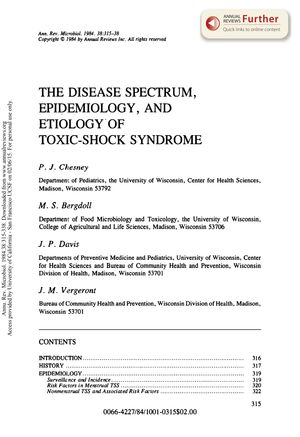The Disease Spectrum, Epidemiology, and Etiology of Toxic-Shock Syndrome
October 1984
in “
Annual Review of Microbiology
”

TLDR Toxic Shock Syndrome cases increased due to new factors, but decreased with public health measures and changes in tampon use.
The document from 1984 reviews Toxic Shock Syndrome (TSS), a condition linked to Staphylococcus aureus and its toxin, toxic shock toxin (TST). It was found that the majority of TSS cases were in menstruating women using tampons, with a notable decrease in incidence after public health interventions and changes in tampon use. By June 15, 1983, 2,204 cases had been reported with a mortality rate that decreased from 10% to 3% after 1980. The incidence of TSS in 1980 was 6-14 cases per 100,000 menstruating women. The document also discusses the clinical presentation, diagnosis, treatment, and recurrence of TSS, noting that recurrence rates for untreated patients could be as high as 65%, but significantly decrease with proper treatment. It concludes that the recent increase in TSS cases was due to newly introduced cofactors, as TST-producing strains and antibodies to TST were present before the rise in cases. The need for a reliable animal model, a laboratory test for TSS, and a better understanding of TST were emphasized for advancing knowledge of TSS and similar diseases.